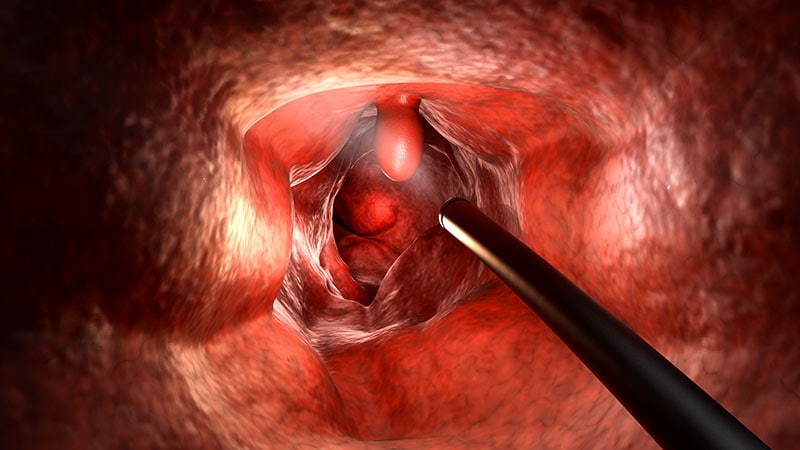
Measurement of the proximal adenoma detection rate may be an important new quality metric for screening colonoscopy, propose researchers in a study that found proportionately more adenomas detected in the right colon with increasing patient age.
As patients age, in fact, the rate of increase of proximal adenomas is far greater than for distal adenomas in both men and women and in all races, wrote Lawrence Kosinski, MD, founder and chief medical officer of Sonar MD in Chicago, and colleagues.

Dr Lawrence Kosinski
Adenoma detection rate, the proportion of screening colonoscopies performed by a physician that detect at least one histologically confirmed colorectal adenoma or adenocarcinoma, has become an accepted quality metric because of the association of high ADR with lower rates of postcolonoscopy colorectal cancer (CRC). ADR varies widely among endoscopists, however, which could be related to differences in adenoma detection in different parts of the colon.
“An endoscopist could perform a high-quality examination of the distal colon and find one adenoma but at the same time miss important pathology in the proximal colon,” the authors wrote. “These differences could be clinically important if CRC occurs after colonoscopy.” The study was published in Techniques and Innovations in Gastrointestinal Endoscopy .
Dr. Kosinski and colleagues analyzed retrospective claims data from all colonoscopies performed between 2016-2018 submitted to the Health Care Service Corporation, which is the exclusive Blue Cross Blue Shield licensee for Illinois, Texas, Oklahoma, New Mexico, and Montana. All 50 states were represented in the patient population, though Illinois and Texas accounted for 66% of the cases.
The research team limited the study group to include patients who underwent a screening colonoscopy, representing 30.9% of the total population. They further refined the data to include only screening colonoscopies performed by the 710 endoscopists with at least 100 screenings during the study period, representing 34.5% of the total patients. They also excluded 10,685 cases with family history because the high-risk patients could alter the results.
Using ICD-10 codes, the researchers identified the polyp detection locations and then calculated the ADR for the entire colon (T-ADR) and both the proximal (P-ADR) and distal (D-ADR) colon to determine differences in the ratio of P-ADR versus D-ADR by age, sex, and race. They were unable to determine whether the polyps were adenomas or sessile serrated lesions, so the ADR calculations include both.
The 182,296 screening colonoscopies included 93,164 women (51%) and 89,132 men (49%). About 79% of patients were aged 50-64 years, and 5.8% were under age 50. The dataset preceded the U.S. Preventive Services Task Force recommendation to initiate screening at age 45.
Overall, T-ADR was consistent with accepted norms in both men (25.99%) and women (19.72%). Compared with women, men had a 4.5% higher prevalence of proximal adenomas and a 2.5% higher prevalence of distal adenomas at any age. The small cohort of Native Americans (296 patients) had a numerically higher T-ADR, P-ADR, and D-ADR than other groups.
By age, T-ADR increased significantly with advancing age, from 0.13 in patients under age 40 to 0.39 in ages 70 and older. The increase was driven by a sharp rise in P-ADR, particularly after age 60. There was a relatively small increase in D-ADR after ages 45-49.
Notably, the P-ADR/D-ADR ratio increased from 1.2 in patients under age 40 to 2.65 in ages 75 and older in both men and women.
Since the experience of the endoscopist affects ADR, the research team also calculated the ADR data by the number of total colonoscopies by endoscopist per decile. T-ADR, P-ADR, and D-ADR were associated directly in a linear relationship with the number of total colonoscopies performed. The slope of the P-ADR trendline was 2.3 times higher than the slope of the D-ADR trendline, indicating a higher volume of procedures directly related to higher polyp detection – specifically the P-ADR.
“Our data demonstrate that it is feasible to measure P-ADR in clinical practice,” the authors wrote. “We propose that P-ADR be considered a quality metric for colonoscopy.”
In addition, because of considerable variation in ADR based on age and sex, calculated ADR should be normalized by the age and sex of the specific patient profile of each endoscopist so relevant benchmarks can be established based on practice demographics, they wrote. For example, an endoscopist with a practice that includes predominantly younger women would have a different benchmark than a colleague with an older male population.
“With appropriate use of gender and age adjustments to ADR, endoscopists in need of further education and mentoring can be identified,” they wrote.
The authors declared no funding for the study. One author reported advisory roles for several medical companies, and the remaining authors disclosed no conflicts.
This article originally appeared in GI and Hepatology News.
Source: Read Full Article